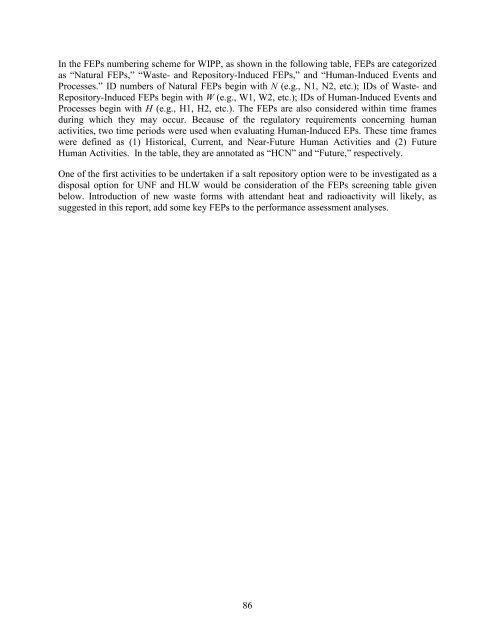Salt Disposal of Heat-Generating Nuclear Waste
Salt Disposal of Heat-Generating Nuclear Waste
Salt Disposal of Heat-Generating Nuclear Waste
Create successful ePaper yourself
Turn your PDF publications into a flip-book with our unique Google optimized e-Paper software.
In the FEPs numbering scheme for WIPP, as shown in the following table, FEPs are categorized<br />
as “Natural FEPs,” “<strong>Waste</strong>- and Repository-Induced FEPs,” and “Human-Induced Events and<br />
Processes.” ID numbers <strong>of</strong> Natural FEPs begin with N (e.g., N1, N2, etc.); IDs <strong>of</strong> <strong>Waste</strong>- and<br />
Repository-Induced FEPs begin with W (e.g., W1, W2, etc.); IDs <strong>of</strong> Human-Induced Events and<br />
Processes begin with H (e.g., H1, H2, etc.). The FEPs are also considered within time frames<br />
during which they may occur. Because <strong>of</strong> the regulatory requirements concerning human<br />
activities, two time periods were used when evaluating Human-Induced EPs. These time frames<br />
were defined as (1) Historical, Current, and Near-Future Human Activities and (2) Future<br />
Human Activities. In the table, they are annotated as “HCN” and “Future,” respectively.<br />
One <strong>of</strong> the first activities to be undertaken if a salt repository option were to be investigated as a<br />
disposal option for UNF and HLW would be consideration <strong>of</strong> the FEPs screening table given<br />
below. Introduction <strong>of</strong> new waste forms with attendant heat and radioactivity will likely, as<br />
suggested in this report, add some key FEPs to the performance assessment analyses.<br />
86
















